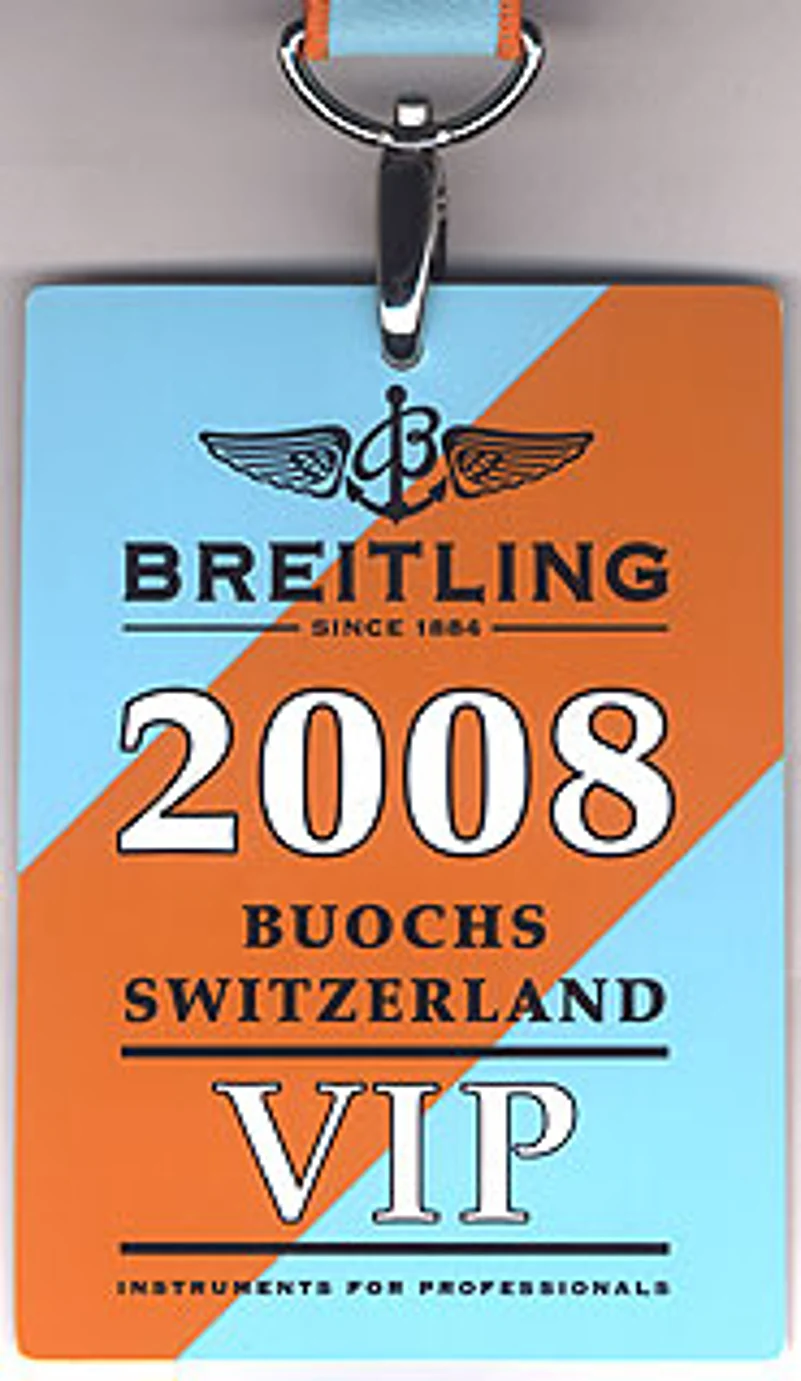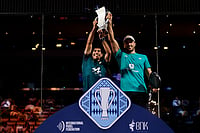
| Entry point: The air show pass |
Breitling has carefully cultivated its link with aviation (John Travolta, its only brand ambassador, is a pilot) by organising this annual air show to show off its famous jet team. With one, delightful difference: "civilians" can participate too. In a manner of speaking, I have 20 aircraft to play around with, be it just for a day.
On a High
The setting is perfect. It's a sunny, clear day. The Buochs airfield rests in the heart of a beautiful valley. On the tarmac, neatly positioned, are the aircraft: seven Czech-made L39 C Albatros, twin-seater military training jets; six 2/3-seater Italian Marchetti SF 260s; there are also some half-a-dozen biplanes ("stay away from them," Arvind Singh warns me, "that's what did Sanjay [Gandhi] in"); and, finally, there's the piece de resistance: a restored Super Constellation, the famous Lockheed airliner of the 1950s. There are only three flight-worthy 'Super Connies' in existence. The pilots, we are reassured, are all top-grade aviators, many recently retired from the French and Italian air forces. Our group—some 30 persons in all, representing France, Belgium, South Africa, South Korea and India—looks out to the runway from a well-stocked, covered deck. Parked around the corner are three gleaming Bentleys (thanks to a range of chronographs dubbed 'Breitling for Bentley') and five-time Le Mans winner Derek Bell promises to throw us the keys for a quick spin. Sounds good to me.
After a 20-minute airshow, where the Albatross fly all over the valley dangerously close in formation, the field is left open to us "civilians". We can sign up for whatever we want to do—squeeze into the jet trainers for a spin, take a half-hour "flight" in the Super Connie, even get strapped to the wing of a biplane. The flights are absolutely breathtaking. But under a piercing summer sun, it's hard work, even though I'm not actually doing the flying. That's all we do over the next six hours or so, broken by a delicious four-course meal. I eat lightly—lunch doesn't go well with loops and hair-raising dives in a jet trainer. Many of our group don't think that far ahead; the air-sickness bags are much in demand.
Finally, late in the afternoon, I muster up the courage to sign my life away for the parachute jump. How was it? Well, I hurtled down for what seemed like a lifetime (but was actually only 40 seconds or so), slipping into the classic parachutists' position and resolutely looking straight ahead. It was an ear-popping rush, followed by a euphoric jolt when the chute thankfully opened (I didn't have to pull the cord after all, Vincent did). Then, after some looking around, I glided into landing position. You need to be an expert at jumping off dtc buses to manage that. Well, let's just put it this way, I didn't fall flat on my face.
Time Pass
For all the brilliant weather, it's hard not to ignore the clouds of disquiet over the Swiss economy. Swiss bank UBS has made heavy losses betting on the US subprime market—nothing short of an earthquake for a country whose biggest contribution to the global economy is the efficiency (and discretion) of its banking system. How could it happen, many people asked, with a disapproving shrug of the shoulder. For the people at Breitling—whose primary customers come from the US, UK, France, and Germany—it's worrying. In times like these, consumers tend to put off purchasing a watch costing thousands of dollars. But as history has shown us, the market for luxury goods is remarkably recession-proof. And then there are always emerging markets like Russia, China and India. Not divulging numbers, Swiss-based polyglot Ravi Venkatachalam—who retails Breitling watches in Mumbai—tells me business in India is good. Not surprising considering how many watches are "gifted" in India—I'm told the taxman is watching.
A visit to the Breitling watch factory at La Chaux-de-Fonds is instructive, for it highlights just how seriously the Swiss take their watches. After being suitably sanitised, we follow the path of the watch from room to room, starting with the assembling of the basic timepiece (also known as a "movement"). It's laborious, high-precision work; typically, a watch takes three months to make, test and check manifold, and Breitling churns out 2,00,000 of them every year.
While there are many middle-aged Swiss ladies hunched over timepieces, the real stars are the master watchmakers who work on "complications", extra features that range from perpetual calendars to multiple time zones. Watchmaking has become a fashionable career option again, after a slump in the 1980s, with the masters earning around $100,000 a year. It's obviously not such a bad thing, after all, passing time.




















